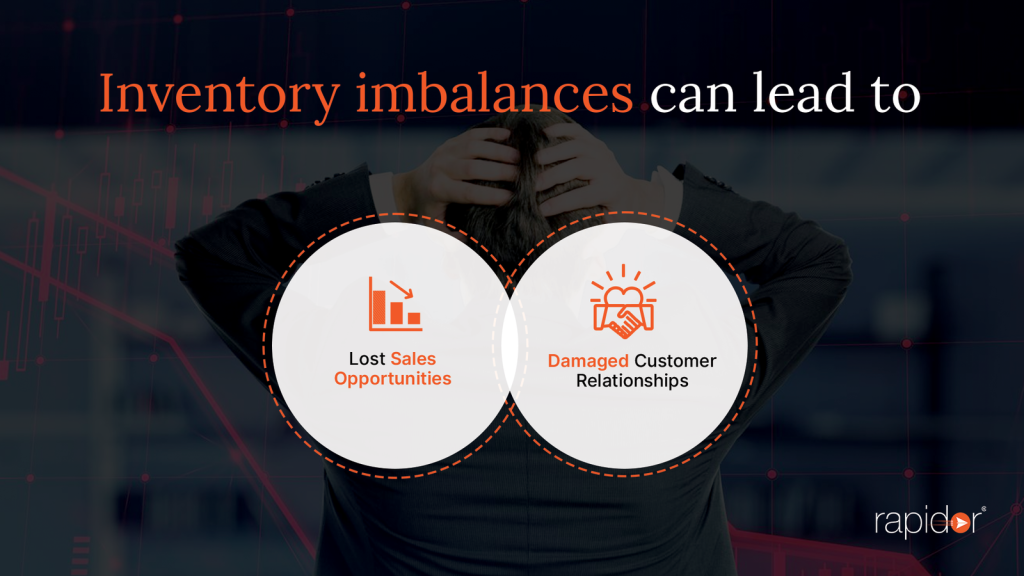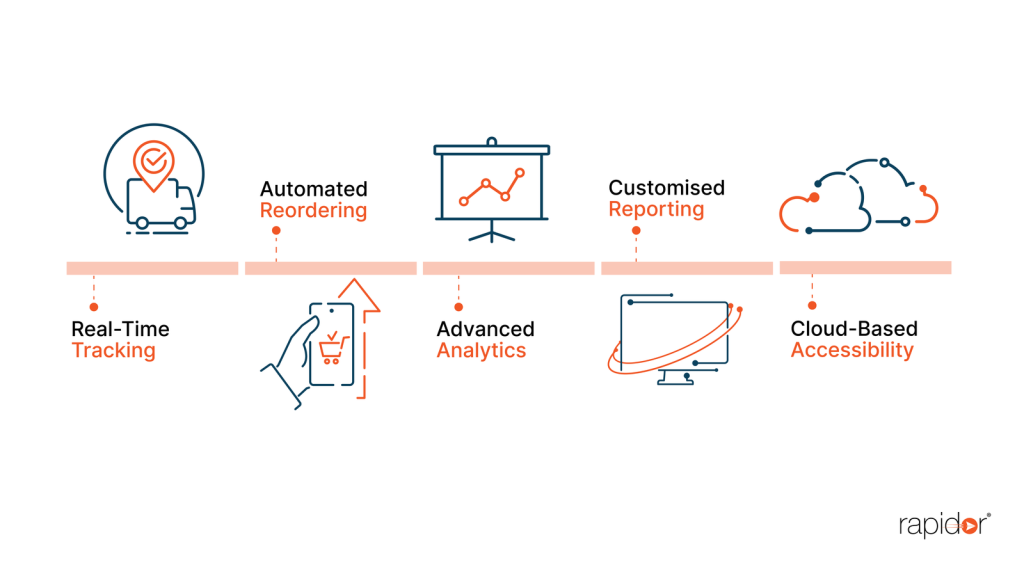In the dynamic world of small and medium-sized enterprises (SMEs), inventory management often emerges as a challenging task, especially when balancing stock across multiple locations.
These organisations frequently grapple with challenges such as inventory imbalances, stockouts, and overstocking. Each of these issues can significantly impede operational efficiency and customer satisfaction.
The complexities are further amplified by the need for real-time visibility into stock levels, a crucial aspect often lacking in traditional inventory control management systems.
To address these multifaceted challenges, a revolutionary approach is required.
Enter the Synchronized Stock Strategy (SSS) – a holistic method that reimagines how inventory is managed across dispersed locations. This strategy hinges on integrating inventory data, ensuring that all locations are harmoniously aligned, thus enabling SMEs to wield their inventory with precision and agility.
SSS promises to streamline inventory management processes and positions SMEs to leverage the best inventory management software and systems to their full potential. As a result, it turns a cumbersome challenge into a strategic advantage.
Understanding Multi-Location Inventory Management: How is it Different?
Multi-location inventory management is an intricate process where SMEs oversee and control stock across various geographical locations.
This practice is pivotal for businesses aiming to optimise their supply chain and maintain competitiveness. Effective inventory management systems are essential in this context, ensuring that each location has the right product mix and quantity to meet local demands.
Common Challenges: Inventory Imbalances, Stockouts, and Lack of Real-Time Visibility
SMEs often face substantial challenges in this arena, primarily inventory imbalances, which can lead to overstocking or stockouts – both detrimental to operational efficiency.
The absence of an automated inventory management software system exacerbates these issues,
making it difficult to achieve a holistic view of inventory status across different locations.
Impact on Operations, Costs, and Customer Satisfaction
These challenges have a ripple effect, impacting the operational aspect, while inflating costs and diminishing customer satisfaction.
Inventory imbalances lead to capital being tied up in excess stock, while stockouts result in lost sales opportunities and damaged customer relationships.

Moreover, the lack of real-time visibility in inventory control management hinders quick decision-making, further impacting the business’s agility and responsiveness.
To mitigate these issues, SMEs are increasingly turning towards the best inventory management software solutions that offer real-time tracking and analytics, enabling them to synchronise their inventory operations effectively across all locations.
Integrating Inventory Data Across Locations: More Hassle or Greater Productivity?
For SMEs managing multiple storage facilities or sales outlets, the significance of a unified inventory view cannot be overstated.
This consolidated perspective, facilitated by advanced inventory management software, is crucial for ensuring that every location’s stock levels are accurately reflected and managed.
A unified view empowers businesses with the ability to make informed decisions, based on comprehensive and real-time data, thereby enhancing operational efficiency and customer satisfaction.
Strategies for Data Integration and Synchronisation
To achieve this integrated inventory landscape, SMEs should employ strategies that involve the deployment of the best inventory management software systems.
These systems should offer features such as real-time data synchronisation, ensuring that changes in one location are instantly reflected across the network.
Implementing automated inventory management software can streamline the process, reducing manual errors and delays.
Effective integration involves standardising data formats across different locations to facilitate seamless communication and data exchange. By adopting these strategies, SMEs can move towards a more synchronised and efficient inventory management system, ultimately driving growth and profitability.
Real-Time Tracking and Responsive Replenishment: Implementing Modern Solutions
Real-time inventory tracking is a game-changer in the world of multi-location inventory management.
By utilising inventory management systems that offer real-time capabilities, businesses can gain instant visibility into their stock levels across all locations.
This immediate access to data helps in making proactive decisions, reducing the risk of stockouts and overstocking, and ultimately enhancing customer satisfaction.
Techniques for Responsive Replenishment
Responsive replenishment is key to maintaining optimal inventory levels.
Techniques include demand forecasting, which uses historical sales data to predict future needs, and automated reordering systems within inventory management software.
As a result, it triggers replenishment orders based on predefined stock thresholds. These techniques ensure that inventory is refilled just in time, balancing the fine line between demand satisfaction and excess inventory.
Role of Automated Inventory Management Software
Automated inventory management software plays a pivotal role in both real-time tracking and responsive replenishment.
It integrates various data points to provide a cohesive picture of inventory needs across locations.
The best inventory management software comes equipped with tools for analytics, forecasting, and automated reordering, making the replenishment process both efficient and timely.
This software saves time and reduces manual errors, contributing to smarter, data-driven decision-making for inventory control management.
Optimising Stock Levels: What Should You Know?
To optimise stock levels effectively, SMEs must delve into analysing sales trends and understanding regional demand variations.
This analysis involves examining historical sales data to identify patterns and trends, which can inform future inventory decisions.
By leveraging these insights, businesses can predict which products are likely to be in high demand in specific locations, allowing for more accurate stock allocation.
Balancing Stock Levels to Reduce Holding Costs and Avoid Stockouts
Balancing stock levels is crucial for minimising holding costs and preventing stockouts.
The key lies in maintaining enough inventory to meet customer demand without overstocking, which ties up capital and increases storage costs.
Automated inventory management software is instrumental in this balancing act.
It can provide real-time data and analytics, enabling businesses to maintain optimal inventory levels across all locations. This strategic balance ensures that businesses can meet customer demands promptly while keeping costs in check, thereby maintaining operational efficiency and profitability.
Synchronized Stock Strategy (SSS): A Holistic Approach
Synchronized Stock Strategy (SSS) is an innovative approach to inventory management, particularly for SMEs dealing with multiple locations.
This strategy is centred around the synchronisation of inventory data across all locations to ensure a harmonious balance of stock. SSS goes beyond mere tracking, using a proactive approach to predict and respond to inventory needs effectively.
How SSS Streamlines Inventory Management Across Multiple Locations
SSS streamlines inventory management by integrating data from various locations into a single, accessible system.
This integration allows for a comprehensive view of stock levels, enabling businesses to make informed decisions about inventory distribution.
With SSS, inventory discrepancies between locations are significantly reduced, ensuring that each location has an optimal stock level based on its unique demand and sales trends.
Such a strategy minimises the risks of overstocking and stockouts, ensuring efficient resource utilisation and reduced holding costs.
The Role of Technology in Implementing SSS
Technology plays a critical role in the successful implementation of the Synchronized Stock Strategy.
Advanced inventory management software and systems are at the core of SSS, providing the necessary tools for data integration, real-time tracking, and analytics.
These systems enable seamless communication between different inventory locations, ensuring that data is consistently updated and synchronised.
Automated inventory management software further enhances this strategy. It facilitates predictive analytics and automated reordering processes, thus ensuring that each location maintains its ideal stock level.
By leveraging these technological solutions, SMEs can effectively implement SSS. This can lead to improved operational efficiency, cost savings, and enhanced customer satisfaction.
The Role of Inventory Management Software
The best inventory management software systems are distinguished by a suite of features designed to simplify and enhance the inventory management process.

The Importance of Real-Time Tracking
A crucial feature of the best inventory management software, real-time tracking provides immediate updates on stock levels and movements across all locations.
This capability ensures that inventory managers have up-to-the-minute information, crucial for making timely decisions to prevent stockouts or overstocking.
It enhances responsiveness to market demands and allows for rapid adjustments in inventory strategy.
What is Automated Reordering?
Automated reordering revolutionises inventory control management by using data-driven insights to maintain optimal stock levels. This feature triggers replenishment orders when inventory falls below a certain threshold, ensuring continuous availability of products and minimising manual intervention in the ordering process.
How Does Advanced Analytics and Reporting Help?
This feature transforms raw inventory data into actionable insights.
By analysing trends and patterns in sales and inventory data, the software aids in forecasting future inventory needs, identifying best-selling items and pinpointing slow-moving stock. These insights are invaluable for strategic planning and optimising inventory turnover.
Moreover, the ability to integrate seamlessly with other business systems, like ERP and CRM, is a hallmark of the best inventory management software.
This integration centralises data, streamlines operations, and provides a unified view of inventory, sales, and customer interactions. As a result, it leads to more informed decision-making and efficient business processes.
The Advantages of Cloud-Based Accessibility
Cloud-based inventory management systems offer the flexibility of accessing inventory data from anywhere, at any time.
This feature is especially beneficial for businesses with multiple locations, as it allows for centralised control and management of inventory. Cloud-based solutions ensure data security, scalability, and real-time synchronisation across all platforms and devices.
How Technology Aids in Effective Inventory Control Management
Technology, particularly through sophisticated inventory management systems, plays a pivotal role in effective inventory control management.
These systems automate many of the labour-intensive tasks associated with inventory management, such as data entry, order tracking, and reporting.
This automation reduces the likelihood of human error, increases efficiency, and frees up staff to focus on more strategic tasks.
Furthermore, technology facilitates better decision-making by providing accurate, up-to-date information on inventory levels, sales trends, and customer demands. This data-driven approach enables businesses to anticipate changes in demand and adjust their inventory accordingly.
Hence, it leads to more efficient operations and improved customer satisfaction.
Multi-Location Inventory Management: How Crucial is it for SMEs?
Mastering multi-location inventory management is crucial for SMEs in today’s competitive market.
Key strategies include implementing real-time tracking, utilising automated reordering, and leveraging advanced analytics from the best inventory management software. These tools provide invaluable insights into sales trends and regional demands, enabling businesses to optimise stock levels effectively.
The Synchronized Stock Strategy (SSS) further enhances this approach by integrating data across all locations for a unified inventory view.
SMEs are encouraged to adopt this data-driven approach to inventory optimization, which streamlines operations and significantly reduces costs, enhancing customer satisfaction.
By embracing these strategies and harnessing the power of automated inventory management software, SMEs can achieve greater efficiency, profitability, and resilience in their operations.
Ready to Transform Your Inventory Management Approach?
Explore Rapidor’s comprehensive inventory management solutions tailored for SMEs.
Visit our website to learn more about our innovative software that simplifies multi-location inventory management. For personalised insights and to see our system in action, contact us today or book a demo.
Embrace the future of inventory management and drive your business growth with Rapidor’s automated services.


